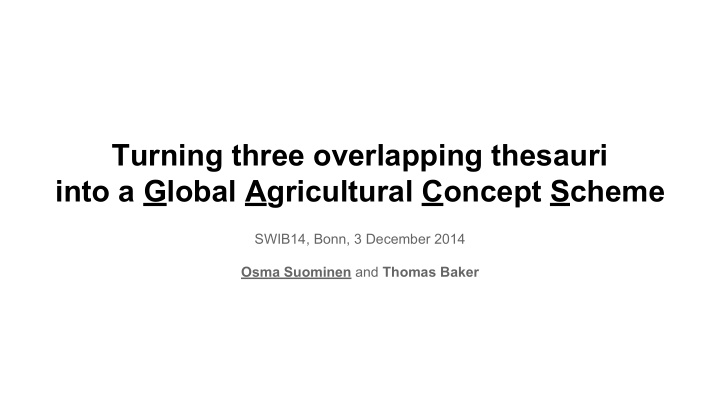



Turning three overlapping thesauri into a Global Agricultural Concept Scheme SWIB14, Bonn, 3 December 2014 Osma Suominen and Thomas Baker
Outline 1. Background 2. Starting point: three thesauri 3. Creating GACS 4. Challenges 5. Next steps and future of GACS
Background ● Food and Agriculture Organization of the UN ● CABI (UK) ● National Agricultural Library (US) Each organization maintains a thesaurus of terms and concepts related to agriculture -- concepts like rice , ricefield aquaculture , and plant pests .
Global Agricultural Concept Scheme (GACS) 1. To improve the semantic interoperability of thesauri maintained by FAO, CABI, and NAL. 2. To provide core concepts broadly supported across the three thesauri. 3. To achieve efficiencies of scale by maintaining the core concepts in cooperation.
Three Thesauri
Separate thesauri, separate databases Create GACS as a glue linking them together
AGROVOC CAB Thesaurus NAL Thesaurus 53,000 32,000 140,000 concepts, concepts, concepts, >200k terms >1.2M terms >1.4M terms English, Spanish, English, Spanish, English, Spanish Portuguese, German, Portuguese, Dutch Czech, Persian, Polish, + many languages with Hindi, French, Italian, lower coverage Russian, Japanese, Hungarian, Chinese, Slovak, Thai, Lao, Turkish, All thesauri represented using SKOS Korean, Arabic, Telugu ...
Overlap estimate Obtained via automatic mappings created using AgreementMakerLight
Long tail distribution (in AGRIS) 10,000 concepts cover nearly 99% of occurrences in metadata
Creating GACS
Requirements and Wishes 1. An integrated view and bridge of existing thesauri 2. Reuses thesaurus development work, incl. translations 3. Compatible with existing databases 4. Based on RDF technologies: URIs, SKOS etc. 5. Available as Linked Open Data Currently building GACS Beta , a proof-of-concept implementation attempting to fulfill most requirements
Selection of top 10,000 concepts Each partner organization provided the 10,000 concepts most frequently used in their respective databases. These lists of concepts were modified as follows: ● added all countries (from AGROVOC) ● added organisms hierarchy all the way to the top
Automated mappings Created using AgreementMakerLight software between the full thesauri, for completeness AgreementMakerLight was top performer at OAEI 2014 ontology mapping competition!
Human evaluation of mappings Created Google Docs spreadsheets using the lists of selected concepts and the auto-generated mappings. Three sheets with circa 10,700 rows each. Mappings manually evaluated by staff of partner organizations. Evaluated 60 to 150 rows/hour, total evaluation time over 300 hours so far. Currently projected to take 500-600 hours for GACS Beta.
Forming GACS concepts by merging the source concepts and aggregating their information cereals Oryza exactMatch exactMatch agrovoc:c_5435 agrovoc:c_1474 UF feed cereals UF Padia cabt:82917 cabt:26247 UF small grain cereals (grain) UF rice (plant) nalt:56271 Oryza sativa rice UF Oryza glutinosa agrovoc:c_6599 exactMatch exactMatch agrovoc:c_5438 UF paddy UF Oryza indica cabt:101613 cabt:82935 UF paddy rice UF Oryza japonica nalt:56293 nalt:56277 UF Oryza sativa … (subsp, var etc.) (actually we use SKOS, not traditional thesaurus tags)
Size of GACS GACS Beta GACS will have around 14,000 of the most used concepts
Quality evaluation Using the qSKOS and Skosify tools that can find and correct problems in SKOS vocabularies [1], we can detect ● missing, invalid or overlapping concept labels ● anomalies in concept hierarchy, e.g. cycles ● ...and many other kinds of problems. Many problems are expected due to merging of concepts within GACS, but most should be automatically corrected. [1] Osma Suominen and Christian Mader: Assessing and Improving the Quality of SKOS Vocabularies . JoDS, 3(1) 2014.
Demo of GACS Alpha in Skosmos
Lessons already learned ● It is hard to sustain focus on mapping beyond circa five hours per day. ● Mapping reveals issues with both the source and target thesauri -- areas for improvement, or errors, fixable in collaboration. ● Starting with the 10,000 most-used concepts shines a light on parts of thesauri that may long have lacked attention. ● Starting small, with a core, avoids the potential stress of over-committing resources. ● Mapping provides an incentive to adopt open-data technologies that can have prove beneficial in other areas.
Challenges
Differences in modeling Q: Are taxonomic organism names (e.g. ‘Bos taurus’ ) different concepts than the common names ( ‘cattle’ )? ● sometimes there is no 1:1 match and/or context of use is different ● the source thesauri all have different policies No final answer yet...
Lumps clusters of concepts mapped one-to-several, several-to-one, or in spirals
Next steps and future of GACS
Additional mapping rounds Need to perform 2-3 more smaller mapping rounds in order to ensure that all necessary concepts have been fully mapped between all source thesauri
GACS system infrastructure
VocBench for editing
Beyond GACS Beta? Q: Can GACS replace existing agricultural thesauri? ● definitely not with GACS Beta due to smaller scope/size ● a future GACS may be an alternative for some scenarios, but not all uses of existing thesauri because ○ they cover areas beyond agriculture ○ existing systems and processes (publication, automatic indexing…) depend on current thesauri In future, more partners are expected and the scope of GACS can be adjusted.
Thank you Reports available on the FAO AIMS site: http://aims.fao.org/community/agrovoc/blogs/phase-one-gacs-approved-read-reports These slides: http://tinyurl.com/swib14-gacs osma.suominen@helsinki.fi tom@tombaker.org
Recommend
More recommend